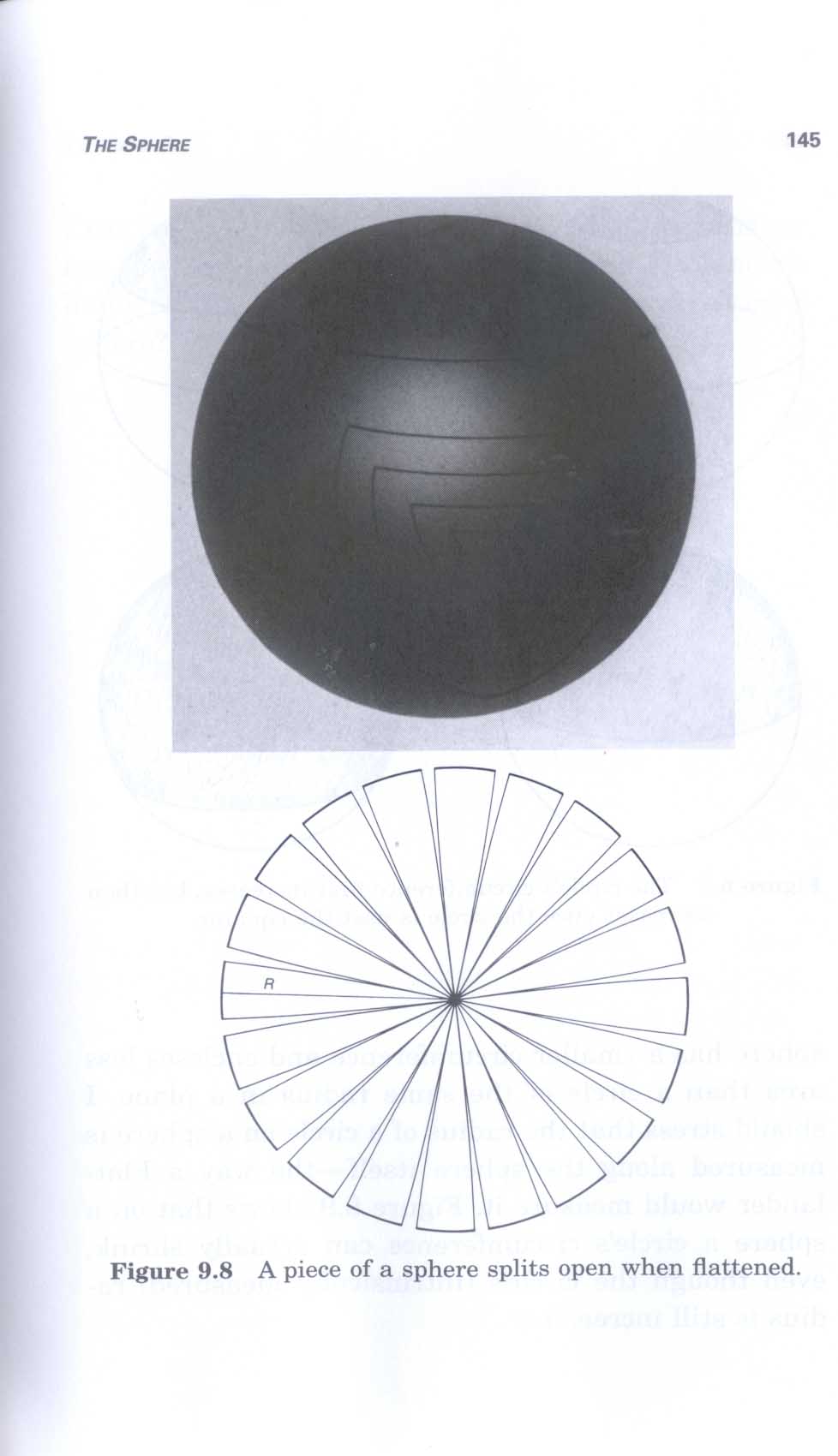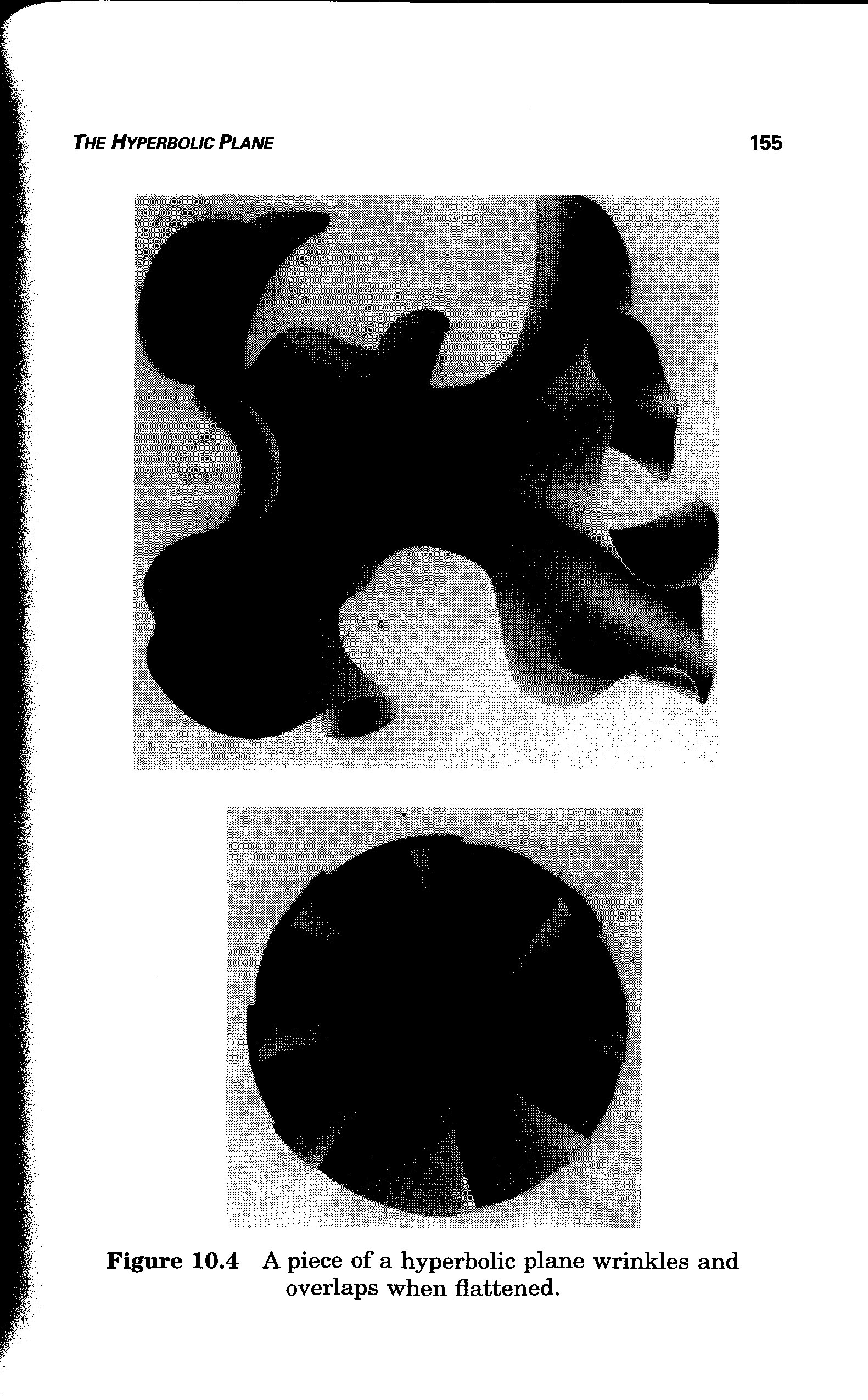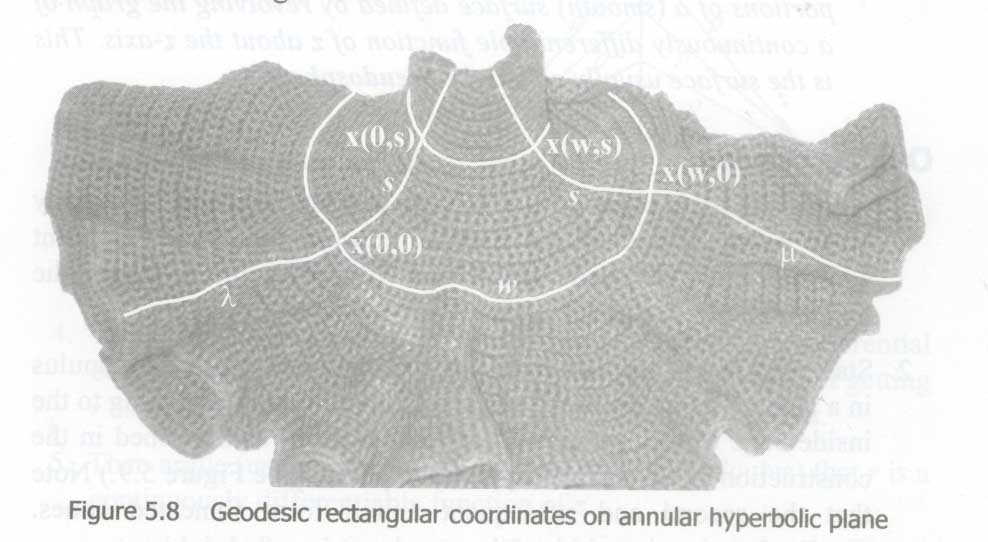
Non-Euclidean Geometry Online: a Guide to Resources
by
Mircea Pitici
June 2008
Good expository introductions to non-Euclidean geometry in book form are easy to obtain, with a fairly small investment.[1] The aim of this text is to offer a pleasant guide through the many online resources on non-Euclidean geometry (and a bit more). There are also three instructional modules inserted as PDF files; they can be used in the classroom.
The geometry around us
Geometry must be as old as humans’ struggle for survival. Building a good hunting bow and getting the best arrows for it surely involved some intuitive appreciation of space, direction, distance, and kinematics. Similarly, delimitating enclosures, building shelters, and accommodating small hierarchical or egalitarian communities must have presupposed an appreciation for the notions of center, equidistance, length, area, volume, straightness.
Some of these deceptively “clear” terms remain more ambiguous than a cursory view accords them. We are not always well served by the millennia-long mathematical acculturation that pervades even our best available instruction in school geometry.
Curious geometrical patterns are ubiquitous. Next time you are in the produce section of a supermarket, take a close look at some fruits and vegetables with particularly interesting configurations. Look, for instance, at the Romanesco broccoli, at kale and lettuce , and at the pineapple. Or walk over to the floral department and search for flowers with sophisticated conformations. You might see arrangements no less interesting than the ones discernable in the vegetables. Here are some computerized renderings.
The beauty embedded in these naturally occurring patterns is not only pleasurable but also intriguing. Over the last few decades a growing number of mathematicians worked on making theoretical advances in the study of patterns similar to the ones pictured above. They found suggestive models useful in understanding such patterns and discovered new applications.
Two mathematical fields are particularly apt for describing such occurrences: the theory of fractals and non-Euclidean geometry, (especially hyperbolic geometry).
In this text we will limit ourselves to the latter. The organization of this visual tour through non-Euclidean geometry takes us from its aesthetical manifestations to the simple geometrical properties which distinguish it from the Euclidean geometry.
There are two main types of non-Euclidean geometries, spherical (or elliptical) and hyperbolic. They can be viewed either as opposite or complimentary, depending on the aspect we consider. I will point out some of the theoretical aspects in the final sections of these presentation.
Hyperbolic geometry and handcrafts
Since 1997, when Daina Taimina crocheted the first model of a hyperbolic plane, the interest in “hyperbolic handcrafts” has exploded. The imagination of the crafters is unbound. The reader can explore a wealth of such artifacts on the website of the Institute for Figuring founded by Margaret Wertheim.
With the proliferation of hyperbolic crocheting, more and more exhibitions hosting this work open around the world. Currently (Summer 2008) one is open at the Hayward Southbank Centre Car Park in London, under the title Hyperbolic Crochet Coral Reef, part of the Hyperbolic Coral Reef Project of the Institute for Figuring mentioned above. Other examples of hyperbolic crocheting can be found online here, here, and here.
An excellent starting point for people interested in learning more about this subject is Sarah-Marie Belcasto’s mathematical knitting pages. The website has many other internet links, including a brief bibliography of written resources of a similar nature, and other photos of hyperbolic knitting. Finally, a few more hyperbolic crocheted flowers can be viewed on this site.
The subject was also covered by the national press in the US, for instance in this recent New York Times article, this older one, in Britain’s The Guardian, as well as on the National Public Radio.
At Cornell, Daina Taimina’s crocheted models are essential tools for teaching hands-on and for understanding hyperbolic geometry in high-level undergraduate courses. Her manipulatives are highly versatile. Students experiment with geometrical objects otherwise difficult to visualize and test their intuition of geometrical properties. In a 2004 interview, Cornell’s Daina Taimina and David Henderson explain the historical background and the differences between the geometrical properties of the planar, spherical, and hyperbolic geometries.
The well-known writer on mathematics Ivars Peterson published a column in 2003 on hyperbolic geometry in art and crafts. He exemplifies the building of an “unruly quilt” from cloth-made pentagons sewn together. This construction is well known among the mathematicians preoccupied with hyperbolic geometry. Its theoretical importance (and that of one variation) are discussed in the following instructional module, inserted here in PDF file:
A Google search for the “water strider” mentioned in this module produces numerous descriptions and images. Apparently, the insect even inspires technological advances in robotics.
Art and hyperbolic geometry
The visual potency of the hyperbolic models of non-Euclidean geometry has captured the imagination of artists.[2] The most famous painter to have used hyperbolic models was M.C. Escher. His work is now widely known. The relationship and historical avatars between the circular model of hyperbolic geometry and Escher’s art are presented in this article by Douglas Dunham of the University of Minnesota at Duluth, who also wrote this article on the same subject. Many more resources on Escher’s art and mathematics can be found on this website.
Recent echoes of non-Euclidean shapes found their way in architecture and design applications.
Academic resources for the study of hyperbolic geometry
We now turn our attention to online resources on non-Euclidean geometry (mostly hyperbolic geometry) made available by educational institutions or clearly directed toward instructional purposes.
Geometry Technologies, whose goal is “to bridge science and math to life through software,” hosts and excellent Geometry Center online, with a good section on hyperbolic geometry.
More visualizations of curved spaces are available online on a website maintained by Jeffrey Weeks, the author of the book The shape of space, mentioned in the first endnote to this text. Under the title ‘Curved spaces’ it contains applets able to take you on a curved spaceship through 3-Torus, a hyperbolical dodecahedron, a Poincare dodecahedral space, and a spherical cube. A shortened version of a 1994 article published in the magazine Mathematical intelligencer also has visualizations of several pseudospheres.
A combination of fractal art and hyperbolic geometry can be found at the Hidden Dimension Galleries.
A richly illustrated chapter in all types of geometries is provided by tiling, the problem of covering a given surfaces with shapes of a given form, without gaps or overlaps. A versatile applet for hyperbolic plane tiling with triangles lets the experimenter play with various parameters. Here is another applet, for covering the circle in the Poincare model.
Other good online resources on non-Euclidean geometry can be found on the Visual Mathematics website; the Geometry Junkyard, with its Tilings of Hyperbolic Spaces page; as well as on the pages maintained by independent groups of enthusiasts, like this, or this. The Wikipedia page on non-Euclidean geometry also has merits. Much weaker in terms of theory (but good for some bibliographical references) is the entry on non-Euclidean geometry in Wolfram MathWorld.
Several websites offer excellent dynamic software. One is Topology and Geometry Software maintained by Jeff Weeks. Another one is Geometry and motion, maintained by Daniel Scher.
Drexel University maintains a remarkable Math Forum online, with a good page on hyperbolic geometry. Another one is maintained by a group of three mathematicians at various universities.
The basics
For millennia, the idea that no-Euclidean geometries might exist was anathema among mathematicians. Karl Friedrich Gauss, arguably the best mathematician ever, delayed publishing his research on non-Euclidean geometry, fearing that he could compromise his reputation.
Throughout the last two centuries several intuitive models of non-Euclidean geometries were proposed. In most of them the definitions of basic geometrical notions challenge our commonly held spatial intuitions. They are, nonetheless, self-consistent within the model to which they belong.
So what are non-Euclidean geometries?
Many authors (including some mentioned in this text) wrongly assume, as a matter of definition, that logically self-consistent geometrical structures that do not abide by Euclid’s fifth postulate, are non-Euclidean. Yet spherical geometry – which is non-Euclidean – does abide by Euclid’s fifth postulate. The confusion stems from the fact that Euclid’s fifth postulate and its logical equivalents in planar geometry are not always equivalent in non-planar geometries. The best discussion of this topic can be found in Henderson & Taimina’s book quoted in the endnote 1. In chapter 10 the reader finds a detailed table comparing various forms of Euclid’s fifth postulate in planar, hyperbolic and spherical geometries.
One of the many ways of comparing these geometries and the planar Euclidean geometry is to look at the sum of the interior angles of a triangle in each of them. In the spherical geometry the interior angles always add up to more than two right angles (180 degrees), in the planar geometry they add up to exactly two right angles, while in the hyperbolic geometry they add up to less than two right angles.
Here is an example of a triangle on a sphere, with three right angles (adding up, therefore, to 270 degrees):[3]

and another one, in which all angles exceed a right angles and the triangle’s area (the shadowed part) is almost as big as the whole spherical surface:[4]

From Daina Taimina’s collection of crocheted hyperbolic planes, the following has a triangle marked in light colors; the measures of the angles add up to less than 180 degrees:[5]

It can be shown that in each type of non-Euclidean geometry the sum of the interior angles of a triangle is directly related to the area of the triangle. Also, the area of a geometrical figure depends on “how much curved” the surface is – on the curvature of the surface.
For a spherical surface we can loosely speak about an ‘area deficit’ due to its curvature (since we get area “gaps” if we flatten it onto a Euclidean plan):[6]

To the contrary, in the case of a hyperbolic surface we can speak about an “area surplus” or abundance (since we get overlaps if we flatten it onto a Euclidean plan):

Area of a circular surface grows differently in each type of geometry. In Euclidean planar geometry it grows proportional with the square of the radius of the circle. In hyperbolic geometry it grows exponentially with the growth of the radius. In spherical geometry the area grows with the radius but it cannot exceed the area of the whole spherical surface.
The three geometries also differ is the system of coordinates best implemented in each. This issue is of great importance for the computational treatment of each type of geometry. We are widely acquainted with the rectangular system of coordinates for the Euclidean plane.
For a sphere, the most familiar coordinate system is the latitude/longitude grid used in geodesy to identify locations of the surface of the earth. Yet that one is not without ambiguity, as shown in a public radio interview on the subject of Hurricane Katrina. I insert here an instructional module focused on the two most commonly used coordinate systems, planar and spherical:
On a hyperbolic plane the most convenient system of coordinates is also rectangular, as shown in the following picture:[7]

More technical treatment
Non-Euclidean geometry can also be introduced and studied in a highly technical manner. For the reader interested in such an approach we offer a brief bibliography.[8] As one would expect, the online resources are more limited, but not inexistent.
--------------------------------------------
[1] Even without a strong mathematical background, interested readers can find excellent introductory books into the problematic of non-Euclidean geometry. A few I would recommend are the following (in alphabetical order of the authors):
[2] See Henderson, Linda Darlymple. The fourth dimension and non-Euclidean geometry in modern art. Princeton, NY: Princeton University Press, 1983. Most of the book is concerned with multi-dimensional geometry.
[3] The image is taken from Henderson and Taimina’s Experiencing Geometry.
[4] Idem.
[5] Ibidem.
[6] The following two reproductions are taken from The shape of space by Jeffrey Weeks.
[7] See Experiencing Geometry, chapter 5, for a detailed discussion.
[8] Several out of print books found in large academic libraries offer good and succinct introductions in non-Euclidean geometry. Obviously, they omit the visual/instructional developments that make the object of this text:
Among newer books, the following deserve attention:
More technical books include:
For a treatment that takes into account physics, see the following: